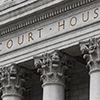Quarterly Journal 46-2
In This Section
The AIPLA Quarterly Journal, a publication of the American Intellectual Property Law Association, is housed at the George Washington University Law School and is edited and managed by an Editorial Board of intellectual property experts and a staff of law students under the direction of the Editor-in-Chief, Professor Joan Schaffner.
The Quarterly Journal is dedicated to presenting materials relating to intellectual property matters and is published four times per year. Editorial Board members (all of whom are lawyers) are selected based upon demonstrated interest and experience, and student staff members are selected from the students of the GWU Law School.
 Do Heightened Quality Incentives Improve the Quality of Patentability Decisions?: An Analysis of Trend Divergences During the Signatory Authority Review Program
Do Heightened Quality Incentives Improve the Quality of Patentability Decisions?: An Analysis of Trend Divergences During the Signatory Authority Review Program
Eric D. Blatt, Lian Huang
Do Heightened Quality Incentives Improve the Quality of Patentability Decisions?: An Analysis of Trend Divergences During the Signatory Authority Review Program
Despite widespread consensus that the quality of patentability determinations must be improved, there has been no agreement as to how this objective should be pursued. A lack of understanding as to the effects of the United States Patent and Trademark Office’s (USPTO) production and quality incentive policies may have presented a barrier to such
 Virtually Equivalent: Applying the Doctrine of Equivalents to Patented Inventions Depicted in Virtual Reality
Virtually Equivalent: Applying the Doctrine of Equivalents to Patented Inventions Depicted in Virtual Reality
Connor J. Hansen
Virtually Equivalent: Applying the Doctrine of Equivalents to Patented Inventions Depicted in Virtual Reality
 Limiting the Expanding Scope of Assignor Estoppel in Federal Courts
Limiting the Expanding Scope of Assignor Estoppel in Federal Courts
Maleena Paal
Limiting the Expanding Scope of Assignor Estoppel in Federal Courts
 The Music Industry’s Discord with the DMCA
The Music Industry’s Discord with the DMCA
Jessica E. Gopiao
The Music Industry’s Discord with the DMCA
Upcoming Events
-
 AIPLA CLE Webinar: Regulation, Risk & Resilience: The Nexus Between Professional Liability, Duty of Competence & Practitioner Well-Being
AIPLA CLE Webinar: Regulation, Risk & Resilience: The Nexus Between Professional Liability, Duty of Competence & Practitioner Well-Being
February 10, 2026 12:30 PM to 2:00 PM | Eligible for up to 90 Mins CLE
Mental health issues and substance use disorders can affect any practitioner, in any setting, and at any time. Left untreated, they can destroy careers and lives. This program will discuss where the legal profession currently stands in relation to the substantial challenges presented by untreated mental health issues and substance use disorders and examine the nexus between ethical competence under the USPTO Rules of Professional Conduct and practitioner well-being. This program will educate attendees on how to recognize the signs of an impaired attorney, how to approach the colleague and begin a conversation, and discuss the possible disciplinary and professional liability implications of an impaired practitioner’s conduct. In addition, the speakers will present best practices/effective risk management strategies, preventative measures, and proposed policy and well-being initiatives, that practitioners in any practice setting may implement to protect clients, themselves, and other firm members as well as save careers. -
.png?sfvrsn=fb5905da_1) 2026 IP Transactions Bootcamp
2026 IP Transactions Bootcamp
February 12, 2026
This in-person bootcamp is designed to provide practical insights and strategies for professionals working in intellectual property transactions. The day features a comprehensive agenda including: Panels and CLE Sessions: Learn about Working with Tech Transfer Offices, Strategies for successful collaborations between nonprofits and industry, and Protecting and monetizing an AI asset. Drafting and Negotiating Tips: Get practical advice on drafting and negotiating strategic collaboration and license agreements. Hands-on Workshop: Participate in a Mock licensing negotiation to put your skills to the test. Networking: Conclude the day with a dedicated Networking reception. -
.png?sfvrsn=48c235e_1) 2026 Patent Prosecution Bootcamp - Arlington, VA
2026 Patent Prosecution Bootcamp - Arlington, VA
March 4 to 6, 2026 | Up to 1235 minutes, including 60 Ethics minutes
The 2026 Patent Prosecution Bootcamp is a comprehensive, CLE-accredited seminar that includes instructional lecture-style sessions with practical tips on U.S. and international patent preparation and prosecution, as well as hands-on interactive workshops that will walk you through drafting claims and responding to office actions. -
2025 Women in IP Global Networking Event
April 16, 2026
-
2026 Spring Meeting - San Francisco, CA
May 13 to 15, 2026
We’re excited to welcome you to the 2026 AIPLA Spring Meeting, where innovation, technology, and intellectual property come together to shape the future. San Francisco is ready for your ideas, energy, and passion for IP!

